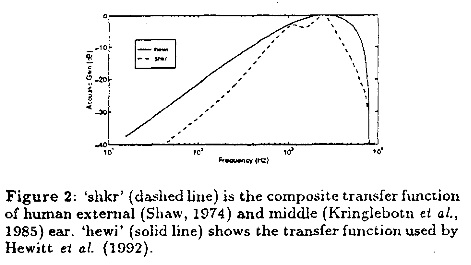
| MadSci Network: Biophysics |
Julius,
This is an interesting question that I hadnít thought about before. I donít exactly know the answer but Iíll tell you what I do know.
For humans (or any other mammal) to hear something, the sound (pressure waves in the air) has to produce vibrations in a chain of structures in the ear. First the pressure waves will cause the eardrum to vibrate. On the other side of the eardrum, in the cavity called the middle ear, a set of little bones (ossicles) connect the eardrum to the cochlea (inner ear). This series of ossicles transmits the vibrations of the eardrum to the oval window on the cochlea. Inside the cochlea, the waves are turned into an electrical signal (firing of neurons) which goes up to the brain and is further processed. For the brain to receive the signal the vibration has to make it all the way through.
The interesting thing is that each of these stages is a physical process which can limit the kinds of sounds that are transmitted. It turns out that one of the reasons we canít hear high frequencies is that the bones of the middle ear just donít vibrate at those frequencies. Think about a singer trying to break a glass by signing at a particular frequency. Thatís the frequency that makes the glass vibrate the most (its resonant frequency) and other frequencies wonít work. The same kind of thing is happening in the middle ear. It vibrates well at certain frequencies and not well or not at all at other frequencies. This property can be measured. Itís called a transfer function. Hereís a graph of the transfer function of the middle ear from a research paper.

It shows different frequencies on the x-axis from low frequencies to high frequencies. On the y-axis it shows the acoustic gain (how much of the vibrations get passed along). You can see that for very high frequencies, the gain is zero, meaning that the middle ears donít vibrate. This means that we canít detect sounds in the air at high frequencies (higher than 20 thousand Hertz) because our middle ear bones donít vibrate at that frequency. Ultrasound is a very high frequency sound, higher than 1 million Hertz (1MHz) which is why we canít hear it.
You asked specifically about injury at high amplitudes (dB). Usually hearing loss due to high amplitude vibrations is a result of damage to the inner ear. The inner ear should not be damaged by high frequency vibrations at high amplitudes because those vibrations donít make it through the middle ear. The middle ear should also be fine for the same reason. The only caveat to this is that the inner ear could be vibrated at higher frequencies if you bypass the middle and outer ear all together by putting the vibration directly on the temporal bone (the side of your head where your ear is). I donít know if the inner ear would then be able to vibrate at this frequency. I think there is some evidence that it could vibrate at higher frequencies than normal but I donít know how high.
What you really asked about was the eardrum. I don't know if it has it's own transfer function (I think it does) and I also don't know what it is. The graph above doesn't separate out the two. If it doesn't vibrate at high frequencies then I think it would be safe. The other thing to consider is that the sound waves actually have to pass through the ear canal before they even get to the eardrum, and that of course has itís own transfer function. You may be detecting a pattern. Basically sound is all about vibration and vibration is all about resonance. Iím assuming that if something doesnít vibrate it wonít be damaged. So the answer to your question about whether ultrasound could damage the eardrum depends on the transfer function of the eardrum and unfortunately I donít know what that is. If youíre worried about it though, there is one reason to think it wouldnít be a problem. That is that the amplitude of sound waves diminishes as it travels through the air, and the higher the frequency, the faster it is absorbed by the air. So a very high frequency sound shouldnít travel very far. Youíd probably have to be pretty close to it for it to damage your ears.
Hereís the paper I got the graph from:
B.T. Tan, P. Dermody, M. Fu, A. Spray (August 1996). The effect of external and middle ear filtering on automatic phoneme recognition. International Symposium on Signal Processing and its Applications, ISSPA, Gold Coast, Australia, 25-30.
This one talks about high frequency sounds not traveling as far through air:
Cyril Harris (1966) "Absorption of Sound in Air versus Humidity and Temperature" Journal of the Acoustical Society of America 40 (1) 148-159.
Thanks for your question,
Meghan Clayards
Try the links in the MadSci Library for more information on Biophysics.